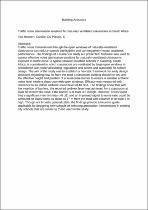 ResearchSpace
ResearchSpace
Traffic noise attenuation solutions for naturally ventilated classrooms in South Africa
JavaScript is disabled for your browser. Some features of this site may not work without it.
- ResearchSpace
- →
- Research Publications/Outputs
- →
- Journal Articles
- →
- View Item
| dc.contributor.author |
Van Reenen, Coralie A

|
|
| dc.contributor.author |
Du Plessis, C

|
|
| dc.date.accessioned | 2022-01-24T06:17:49Z | |
| dc.date.available | 2022-01-24T06:17:49Z | |
| dc.date.issued | 2021-12 | |
| dc.identifier.citation | Van Reenen, C. & Du Plessis, C. 2021. Traffic noise attenuation solutions for naturally ventilated classrooms in South Africa. <i>Building Acoustics.</i> http://hdl.handle.net/10204/12219 | en_ZA |
| dc.identifier.issn | 1351-010X | |
| dc.identifier.uri | https://doi.org/10.1177/1351010X211064000 | |
| dc.identifier.uri | http://hdl.handle.net/10204/12219 | |
| dc.description.abstract | Traffic noise transmission through the open windows of naturally-ventilated classrooms can reduce speech intelligibility and can negatively impact academic performance. The findings of a numerical study are presented. Software was used to assess effective noise attenuation solutions for naturally-ventilated classrooms exposed to traffic noise. A typical situation in urban schools in Gauteng, South Africa, is considered in which classrooms are ventilated by large open windows in accordance with national building regulations and norms and standards for school design. The aim of the study was to establish a heuristic framework for early design decisions regarding how far from the road a classroom building should be set, and the effective height and position of a solid noise barrier to ensure a suitable ambient noise level inside a classroom with open windows. Efficacy was measured with reference to an indoor ambient sound level of 40 dBA. The findings show that with the insertion of barriers, the required ambient level was achieved for a classroom at least 68 m from the road, if the barrier is at least 3.5 m high. However, it was found that a significant insertion loss (>6 dB) and an improved signal to noise ratio could be achieved for classrooms as close as 17 m from the road with a barrier of at least 2 m high. Though not broadly generalizable, the findings provide a heuristic guide applicable for designing new schools or selecting attenuation interventions in existing city schools that are similar to those used in the study. | en_US |
| dc.format | Abstract | en_US |
| dc.language.iso | en | en_US |
| dc.relation.uri | https://journals.sagepub.com/doi/10.1177/1351010X211064000 | en_US |
| dc.source | Building Acoustics | en_US |
| dc.subject | Classroom acoustics | en_US |
| dc.subject | Natural ventilation | en_US |
| dc.subject | Noise barriers | en_US |
| dc.subject | Sound transmission | en_US |
| dc.title | Traffic noise attenuation solutions for naturally ventilated classrooms in South Africa | en_US |
| dc.type | Article | en_US |
| dc.description.pages | 22 | en_US |
| dc.description.note | Copyright: 2021 The Author(s). Due to copyright restrictions, the attached PDF file only contains the abstract of the full text item. For access to the full text item, please consult the publisher's website. | en_US |
| dc.description.cluster | Smart Places | en_US |
| dc.description.impactarea | Infrastructure Innovation | en_US |
| dc.identifier.apacitation | Van Reenen, C., & Du Plessis, C. (2021). Traffic noise attenuation solutions for naturally ventilated classrooms in South Africa. <i>Building Acoustics</i>, http://hdl.handle.net/10204/12219 | en_ZA |
| dc.identifier.chicagocitation | Van Reenen, Coralie, and C Du Plessis "Traffic noise attenuation solutions for naturally ventilated classrooms in South Africa." <i>Building Acoustics</i> (2021) http://hdl.handle.net/10204/12219 | en_ZA |
| dc.identifier.vancouvercitation | Van Reenen C, Du Plessis C. Traffic noise attenuation solutions for naturally ventilated classrooms in South Africa. Building Acoustics. 2021; http://hdl.handle.net/10204/12219. | en_ZA |
| dc.identifier.ris | TY - Article AU - Van Reenen, Coralie AU - Du Plessis, C AB - Traffic noise transmission through the open windows of naturally-ventilated classrooms can reduce speech intelligibility and can negatively impact academic performance. The findings of a numerical study are presented. Software was used to assess effective noise attenuation solutions for naturally-ventilated classrooms exposed to traffic noise. A typical situation in urban schools in Gauteng, South Africa, is considered in which classrooms are ventilated by large open windows in accordance with national building regulations and norms and standards for school design. The aim of the study was to establish a heuristic framework for early design decisions regarding how far from the road a classroom building should be set, and the effective height and position of a solid noise barrier to ensure a suitable ambient noise level inside a classroom with open windows. Efficacy was measured with reference to an indoor ambient sound level of 40 dBA. The findings show that with the insertion of barriers, the required ambient level was achieved for a classroom at least 68 m from the road, if the barrier is at least 3.5 m high. However, it was found that a significant insertion loss (>6 dB) and an improved signal to noise ratio could be achieved for classrooms as close as 17 m from the road with a barrier of at least 2 m high. Though not broadly generalizable, the findings provide a heuristic guide applicable for designing new schools or selecting attenuation interventions in existing city schools that are similar to those used in the study. DA - 2021-12 DB - ResearchSpace DP - CSIR J1 - Building Acoustics KW - Classroom acoustics KW - Natural ventilation KW - Noise barriers KW - Sound transmission LK - https://researchspace.csir.co.za PY - 2021 SM - 1351-010X T1 - Traffic noise attenuation solutions for naturally ventilated classrooms in South Africa TI - Traffic noise attenuation solutions for naturally ventilated classrooms in South Africa UR - http://hdl.handle.net/10204/12219 ER - | en_ZA |
| dc.identifier.worklist | 25268 | en_US |





